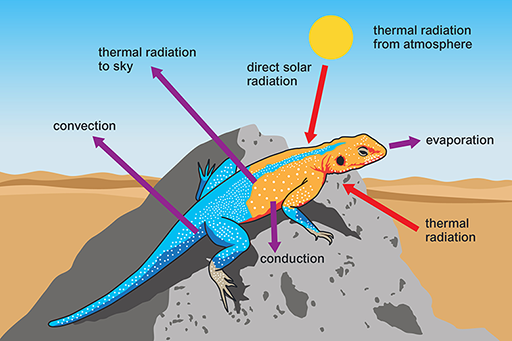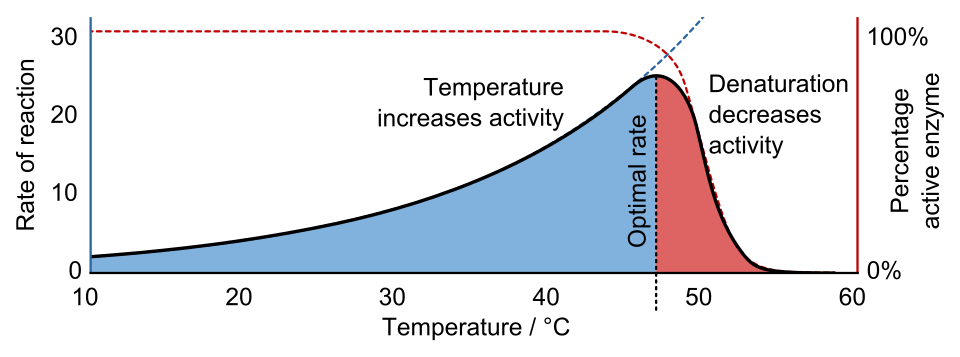OCR Specification focus:
‘Ectotherms rely largely on behavioural responses to regulate body temperature in changing environments.’
Ectothermic animals maintain body temperature primarily through external heat sources and behavioural strategies, adapting effectively to environmental changes to preserve optimal enzyme activity and metabolic function.
Temperature Regulation in Ectotherms
Overview of Ectothermy
Ectotherms are animals whose body temperature depends on the external environment, as they do not generate sufficient internal heat through metabolism to maintain a stable temperature. Their metabolic rate changes directly with temperature, influencing enzyme activity, cellular respiration, and overall physiology.
Examples of ectotherms include reptiles, amphibians, most fish, and invertebrates. These organisms demonstrate remarkable behavioural and physiological adaptations that enable survival in fluctuating thermal environments.
Behavioural Thermoregulation
Adjusting Exposure to Heat and Cold
Behavioural mechanisms are the primary means of temperature control in ectotherms.

A side-blotched lizard basking on a rock with labelled arrows showing heat gain (solar and atmospheric radiation) and heat loss (conduction, convection, evaporation, radiation to sky). The diagram illustrates how posture and microhabitat determine net heat exchange, underpinning behavioural thermoregulation in ectotherms. Note: the terms ‘heliothermy’ and ‘shuttling’ may appear in surrounding text but are not required by the OCR subsubtopic. Source.
These actions either maximise heat gain or minimise heat loss, depending on the environment.
To increase body temperature, ectotherms may:
Bask in sunlight, orienting their bodies to maximise surface area exposed to solar radiation.
Flatten their bodies to increase heat absorption.
Move to warm surfaces, such as rocks heated by the sun.
Adopt dark colouration in colder conditions, as darker pigments absorb more radiation.
To decrease body temperature, ectotherms may:
Seek shade or burrow underground.
Move into water or damp environments for cooling.
Reduce body contact with hot surfaces by standing tall or lifting parts of the body away from the ground.
Orient bodies parallel to the sun’s rays to minimise heat absorption.
These behavioural responses are often highly specific to the animal’s habitat, with desert reptiles showing different strategies from aquatic fish or temperate amphibians.
Examples of Behavioural Control
Lizards such as iguanas bask in the morning sun to elevate their temperature before becoming active, then retreat to shade during the hottest part of the day.
Amphibians like frogs often move between water and land to balance heat exchange and hydration.
Insects regulate temperature through orientation and wing movement, for example, moths vibrating wings to generate heat before flight.
Behavioural thermoregulation is a rapid, energy-efficient means of responding to changing external conditions without requiring complex internal mechanisms.
Physiological and Structural Adaptations
While behavioural strategies dominate, some ectotherms employ limited physiological and structural adaptations that complement behaviour.
Physiological Adjustments
Metabolic rate variation: Some ectotherms can slightly increase metabolic heat production during activity, though not enough to maintain endothermy.
Vasodilation and vasoconstriction: In reptiles, blood vessels in the skin can dilate to enhance heat loss or constrict to conserve heat, albeit less efficiently than in endotherms.
Evaporative cooling: Certain species release moisture or saliva to promote cooling through evaporation.
Structural Features
Body shape and size: Flattened or elongated bodies increase the surface area-to-volume ratio, improving heat exchange.
Pigmentation: Seasonal colour changes can occur, allowing greater absorption in winter and reflection in summer.
Although these mechanisms play minor roles compared with behaviour, they highlight the evolutionary diversity of ectothermic thermoregulation.
Environmental Influence on Metabolism
Temperature exerts a profound influence on enzyme activity and metabolic efficiency.
Q10 Coefficient: The measure of how much the rate of a biological process increases with a 10°C rise in temperature.
A typical Q10 value for metabolic reactions is around 2, meaning reaction rates roughly double with each 10°C increase until enzymes denature or become inactive.

Graph of enzyme rate of reaction versus temperature, illustrating the Q10-driven rise in activity up to an optimum, and the subsequent fall due to denaturation. This visual explains why ectotherm activity patterns track environmental temperature. Note: the graph includes denaturation detail beyond the syllabus phrase but remains directly supportive of OCR expectations. Source.
At low temperatures, ectothermic metabolism slows, reducing energy demand and activity levels. At high temperatures, enzyme denaturation and dehydration can lead to cellular stress or death. This direct link between body temperature and metabolism explains why ectotherms’ activity patterns are closely tied to environmental temperature cycles.
Ecological and Behavioural Consequences
Activity Patterns
Because temperature dictates enzyme efficiency, ectotherms display seasonal and diurnal patterns of activity:
Diurnal ectotherms (e.g. many lizards) are active during daylight when temperatures are optimal.
Nocturnal ectotherms (e.g. desert geckos) are active at night to avoid extreme heat.
Seasonal dormancy such as hibernation in winter or aestivation in hot, dry conditions helps conserve energy when environmental temperatures are unfavourable.
Habitat Selection
Ectotherms inhabit niches that allow effective temperature control:
Aquatic ectotherms experience stable temperatures due to water’s high specific heat capacity.
Terrestrial ectotherms must exploit microhabitats such as burrows, rocks, or vegetation for shelter and thermoregulation.
The ability to exploit microclimates gives ectotherms remarkable ecological flexibility despite physiological constraints.
Advantages and Limitations of Ectothermy
Advantages
Low energy requirements: Ectotherms use less food for metabolic heat production, allowing survival in environments with limited resources.
Greater energy allocation: Energy saved from thermogenesis can be directed towards growth and reproduction.
Adaptability: Behavioural strategies allow rapid responses to changing conditions without complex hormonal control.
Limitations
Temperature dependence: Activity is restricted to favourable conditions; extreme cold or heat can cause immobility or death.
Reduced activity in cold climates: Ectotherms cannot sustain high activity levels during cooler periods, limiting predation or escape responses.
Geographical limitation: Most ectotherms are confined to warm or temperate regions due to environmental reliance.
These trade-offs underpin major ecological differences between ectotherms and endotherms, influencing distribution, behaviour, and evolutionary strategy.
Integration with Homeostasis
Though lacking the internal thermoregulatory mechanisms of endotherms, ectotherms still contribute to the broader principle of homeostasis, maintaining internal balance through external behavioural adjustments. By modifying exposure and activity, they ensure enzyme systems operate within functional temperature ranges, enabling stable internal function relative to environmental change.
In summary, temperature control in ectotherms exemplifies how behavioural and limited physiological responses can effectively maintain internal equilibrium, ensuring survival and biological efficiency in diverse habitats.
FAQ
Ectotherms detect temperature changes using thermoreceptors in the skin and sometimes internally. These receptors send nerve impulses to the brain, allowing the animal to adjust behaviour quickly.
In reptiles, the hypothalamus can detect temperature changes in circulating blood, prompting behavioural responses like basking or seeking shade. This sensory feedback ensures that behavioural thermoregulation is precisely matched to environmental conditions.
Certain ectotherms, such as chameleons and some frogs, use chromatophores—specialised pigment cells in their skin—to alter colour.
Darker colours absorb more radiation, increasing heat gain in cooler conditions.
Lighter colours reflect radiation, reducing heat absorption in hotter conditions.
This colour change is controlled by hormones or neural signals and can occur within minutes, helping maintain a suitable body temperature without extensive movement.
Ectotherms rely on environmental heat, so large body sizes can hinder temperature regulation due to a lower surface area-to-volume ratio.
Because larger ectotherms lose or gain heat more slowly, they struggle to respond quickly to environmental temperature changes. As a result, ectotherms are often smaller or have shapes that increase surface exposure, enabling faster heat exchange and more effective behavioural control.
In fish and amphibians, higher water temperatures reduce oxygen solubility, meaning less oxygen is available.
As metabolic rate increases with temperature, oxygen demand also rises. Ectotherms compensate by:
Increasing ventilation rate (more frequent gill movements).
Enhancing circulation to improve oxygen transport.
Seeking cooler, oxygen-rich water layers when possible.
If temperatures rise too high, oxygen supply may become insufficient, leading to stress or death.
While ectotherms cannot maintain body temperature internally like endotherms, some species can produce limited metabolic heat during activity.
For example:
Insects such as bees and moths generate heat by wing vibration before flight.
Large reptiles (e.g. Komodo dragons) retain heat from muscle activity for short periods.
However, this heat production is temporary and insufficient for full endothermy—it only supplements behavioural regulation.
Practice Questions
Question 1 (2 marks)
Explain how an ectothermic animal, such as a lizard, can increase its body temperature on a cool morning.
Mark scheme:
(1 mark) for reference to basking in the sun or moving into a warmer area to absorb heat.
(1 mark) for explanation that radiation from the Sun increases body temperature or orienting body to maximise heat absorption (e.g. flattening body or turning broadside to the Sun).
Question 2 (5 marks)
Describe and explain how behavioural and physiological mechanisms enable ectotherms to maintain a suitable body temperature in different environmental conditions.
Mark scheme:
(1 mark) for recognising that ectotherms rely primarily on behavioural responses rather than internal heat production.
(1 mark) for increasing body temperature by basking, flattening the body, adopting dark colouration, or moving to warm surfaces.
(1 mark) for decreasing body temperature by seeking shade, burrowing, moving into water, or orientating body parallel to sunlight.
(1 mark) for limited physiological mechanisms, such as vasodilation or vasoconstriction to regulate heat exchange, or evaporative cooling.
(1 mark) for linking these responses to maintenance of enzyme activity/metabolic efficiency or survival in fluctuating environmental temperatures.

